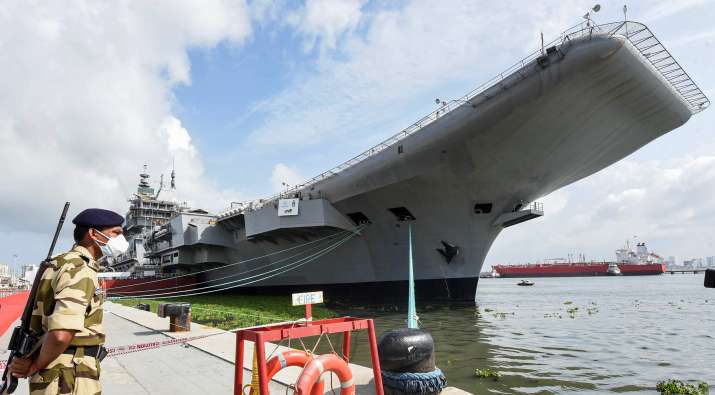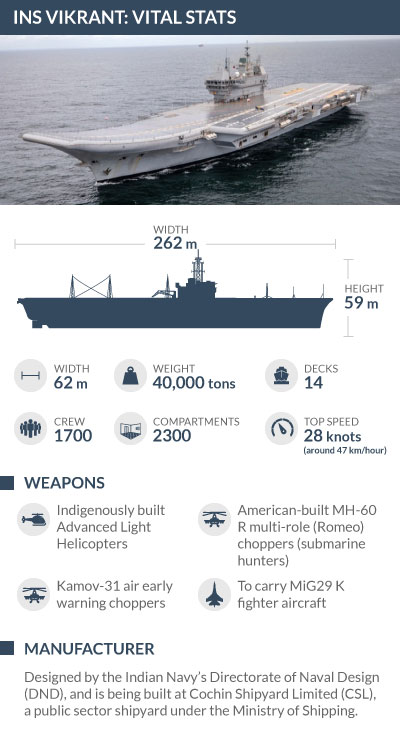
As INS Vikrant takes rebirth, focus shifts to India’s ‘blue water’ capability

First, rewind to India’s naval history: 1971: INS Vikrant, a Majestic-class 19,500-tonne warship, was deployed in the Bay of Bengal. Its two air squadrons of Sea Hawk fighter jets and Alize surveillance aircraft were used in strikes on ports, merchant ships, and other targets, and to prevent Pakistani forces from escaping through maritime routes. The Karachi port was blockaded, which essentially meant capitulation of Pakistani forces.
Fast Forward to Aug 4, 2021: 50 years later, the Indian Navy Day the force hailed the “proud and historic day for India as the reincarnated Vikrant sails for her maiden sea trials…, in the 50th year of her illustrious predecessor’s key role in victory in the 1971 war”.
The Indigenous Aircraft Carrier (IAC) 1 will be called INS Vikrant once it enters service with the Indian Navy about a year from now. This is the first aircraft carrier designed and built in India. IAC-1 has been designed by the Indian Navy’s Directorate of Naval Design (DND), and is being built at Cochin Shipyard Limited (CSL), a public sector shipyard under the Ministry of Shipping.
Also read: India clears ₹43K crore project to build 6 mega stealth submarines
India’s earlier aircraft carriers were either built by the British or the Russians. The INS Vikramaditya, the Indian Navy’s only aircraft carrier that was commissioned in 2013, was originally Soviet-Russian Admiral Gorshkov. The country’s two earlier carriers, INS Vikrant and INS Viraat, were originally the British-built HMS Hercules and HMS Hermes before being commissioned into the Navy in 1961 and 1987 respectively.

An aircraft carrier is one of the most potent marine assets for a nation, which enhances a Navy’s capability to travel far from its home shores to carry out air-domination operations.
Having an aircraft carrier is essential to be considered a ‘blue water’ navy – the one with the capacity to carry a nation’s strength and power across the high seas.
The IAC, the Indian Navy says, is the “largest and most complex warship ever to be designed and built in India”, and a significant achievement in “our quest for Atmanirbhar Bharat and Make in India initiative”. The Navy says IAC will operate the Russian-built MiG-29K fighter aircraft and Kamov-31 air early warning helicopters; the indigenously manufactured Advanced Light Helicopters (ALH); and the soon-to-be-inducted MH-60R multirole helicopters manufactured by Lockheed Martin.
The Navy has also been pushing for a 65,000-tonne warship, but the government is still weighing the need for a third carrier. The Navy feels a third carrier is an operational necessity — Chief of the Naval Staff Admiral Karambir Singh had said on Navy Day (December 3) last year that the Navy did not want to stay “tethered to the shore”, and “air power at sea is absolutely required”.
Also read: Message to China: India sends Naval task force to South China Sea
The keel of the 40,000-tonne warship was laid in February 2009, and it was floated out at Cochin Shipyard Ltd (CSL), which has built it, in December 2011. Basin trials were completed in November 2020, and the vessel is expected to be commissioned into the Navy by August 2022.
With seas on three sides and high mountains on the fourth, it has been said that India lies in the very lap of the Indian Ocean. India possesses the second-largest peninsula in the world. That translates into a coastline of 5,422 km, India’s outlying island territories add another 2094 km, making up a total coastline length of 7516 km.
As the Indian Naval strength gathers momentum, there is a debate whether India needs more aircraft carriers or submarines. Chief Defence Staff, General Bipin Rawat has said: “Both have their advantages and disadvantages. Submarines have their separate place in the naval warfare and so does an aircraft carrier. I am in no way saying the Navy does not need its air wing. But how to manage it and how to ensure the security and sanctity of our sea lines of communication we are thinking about,” he said.
He hinted at an alternative to an aircraft carrier. “I think you also need to look at our Island territories that we have in large numbers. If we can leverage our Island territories to our advantage, then we can balance out… this can be used as territories to launch naval strike aircraft or do we need an aircraft carrier? Once we have studied all that in detail we will take a call,” he said.
On December 3, on the eve of Navy Day last year, Indian Navy Chief of Staff, Admiral Karambir Singh, said that the Navy is determined to acquire a third aircraft carrier. “As a navy, we are absolutely clear of the utility of a third carrier,” Admiral Singh said at a press conference.


